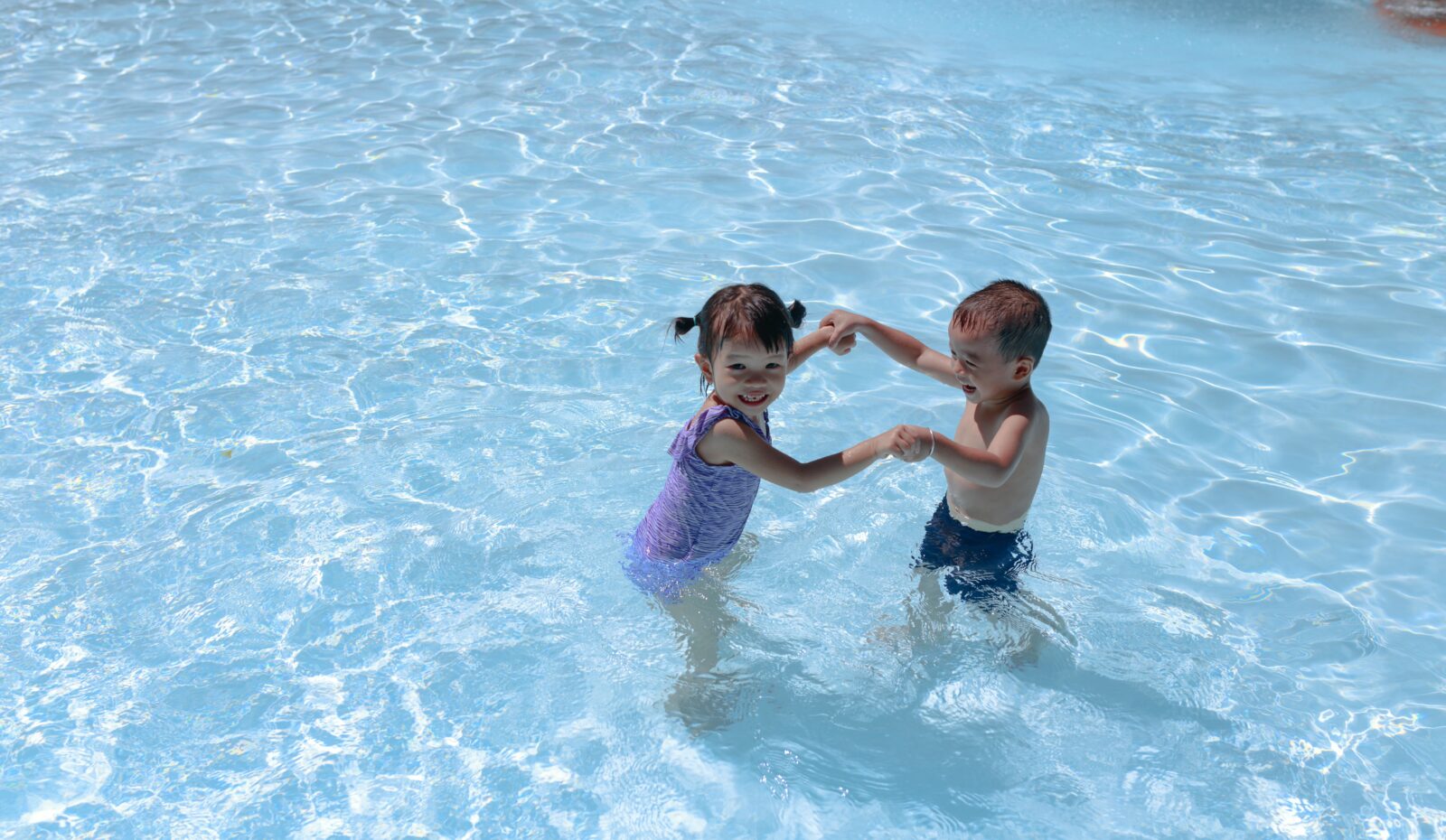If you’re gearing up to start your child in swim lessons this spring, here are some things I can share as a seasoned swimming instructor AND a fellow mom of young kids (including one who cried through swim lessons for an entire season!).
There is no perfect age to start.
Parents often worry that they’ve waited too long to start their kids in swimming lessons. The truth is there is no perfect age.
Once kids are 4 to 5 years old, they have the gross motor skills to start swimming independently. But there are lots of considerations: Do you have a pool? Do you swim frequently? Does your family have time and financial resources to dedicate to lessons right now?
If you are in a difficult season of life, give yourself some grace. Starting lessons at age 3 instead of age 2 will not impact your child’s ability to swim as they get older. Learning to swim is important to help keep your child safe around water, but lifejackets and adult supervision are equally important.
Progress is not linear.
Sometimes a kid will make a giant leap forward when you least expect it. Other times you may feel frustrated if their progress stalls.
All kids develop at their own pace. Getting your arms and legs to work together takes a lot of coordination!
Even if your child is in a class with peers of the same age, remember all of the development that takes place in the span of a year. There is a big difference between a child who just turned two and one who is nearly three.
If you see a really advanced swimmer, there’s a good chance they swim a ton in their own pool or at a grandparent’s house. Your child will catch on if you stick with it!
Crying is contagious.
As a mom, I know how difficult it is to watch your child cry. As a swimming instructor, I know certain age groups are prone to tears. Crying does not stress me out as an instructor.
There are lots of reasons kids cry. It could be separation anxiety, a new environment, cold water or the fact that a crazy lady in and hat and sunglasses is asking me to try new things. When one child starts crying, others will almost always follow suit.
I want your child to feel safe and secure. I have lots of techniques to help, but some kids are just unhappy during their first few lessons.
If you can just push through, most students come to enjoy swimming lessons.
Real talk – My son cried during most of his lessons when he was three. I bribed him with ice cream and it worked like a charm. The next summer he didn’t shed a single tear but asked for ice cream every day. So do with that what you will.
Sometimes lessons go better when you don’t watch.
If you do have a child that is struggling, I recommend you move out of sight. Often, our kids look at our reactions to decide if they should be worried. If they sense we are anxious, they will be too.
When I’m the primary adult in the pool area, I can better bond and build trust.
This applies to older kids as well. They are often so busy looking to see if you are watching them that they miss my instructions or feedback.
I don’t expect perfect behavior.
I’m unfazed if your child splashes me in the face, kicks me or throws a toy. When it’s a safety issue – like if a child jumps in the water without permission – I will address it kindly and firmly, explaining the danger.
When a parent swoops in to discipline their child, it can be disruptive. Suddenly the whole class is focused on their parent’s reaction instead of watching me.
Using floaties all the time may hold your child back.
Puddle jumpers and floaties can be great tools to help keep your child safe, especially if you have more than one kiddo in the water!
However, too much reliance on puddle jumpers can create bad habits.
Floaties are designed to keep your child’s head above water. Kids learn to get around the pool without putting their faces in. The problem is – when kids try to swim with their heads up; it’s like swimming uphill. It’s possible, but twice as much work.
Don’t sacrifice safety, but join your child in the water for some practice and play without floaties when you can.
Come ready to swim.
This one may seem obvious, but there are some things to consider.
If your child has long hair, DO pull it back in a ponytail or braid. New swimmers tend to “slurp” up their hair when they are first learning to blow bubbles.
Please DON’T send your child in a hat. As a swimming instructor, it’s essential that I can see when your child takes a breath. A hat gets in the way.
I don’t mind goggles as long as your child isn’t distracted by them. Some kids fuss with their goggles as a stalling technique and others really benefit from them. Please leave toys, nose plugs and floaties at home.
If your child needs some extra support with sensory processing, I often suggest bringing a washcloth they can use to wipe their face at the end of their turn.
Children learn through play.
I have playtime at the end of every lesson. I often find that reluctant swimmers will try new skills on their own as they play.
Every time that you get in the water with your child, they are practicing and getting stronger.
You may see your child diving for rings on the steps. I see a child learning to control their breath, and buoyancy while practicing turning, submersion and water entry/ exit skills.
Teaching your own child can be tricky.
I have taught swimming lessons for 20!! years. I’ve helped kids overcome fears and troubleshoot difficult strokes, but my most challenging students have been my own two kids.
I have an endless amount of patience with other kids, but working with my own can be frustrating. There is a lot of emotional weight that goes into teaching your child. As a parent, it is difficult to be objective.
We will teach our kids lots of things over the years. But, if are like me – you find yourself biting your tongue and taking deep breaths – know that you are not alone.
Swimming programs do not make your child “drown-proof.”
No one (adults included) is completely drown-proof. Even highly-skilled swimmers can get into trouble in the right conditions. That’s why certain scenarios call for the buddy system, life jackets and lifeguards for kids and grown-ups.
Swimming lessons greatly decrease the risk of drowning, but swimming programs aren’t one size fits all.
The best swimming program is the one that works well for your entire family unit. The decision to take private vs. group lessons or traditional vs. Infant Self Rescue (ISR) is a highly individual decision.
First, find the program that fits within your family’s schedule and budget.
Then, ask around for instructor recommendations. Be wary of teachers who are only lifeguards. A good instructor will have a nationally-recognized certification, like the American Red Cross Water Safety Instructor.
A great instructor will be firm, but kind. They will push your child out of their comfort zone….and they will book up fast. It’s not too early to start thinking about summer lessons in early spring. 🙂
More About The Author
In addition to her work as a freelance writer (and contributor to The Mom Hour!), Jennifer Carroll loves to spend time in the water with family and friends. She got her start as a lifeguard and has continued to teach swimming lessons for the past 20 summers.
Jennifer met her husband on Oklahoma State’s wakeboarding team and was a boat driver, waterskiing, and wakeboarding instructor at sleep-away camps in New York and Texas.
Jennifer has earned her:
- American Red Cross Lifeguard Certification
- American Red Cross Water Safety Instructor Certification
- Open Water Rescue Certification
- American Heart Association Basic Life Support Certification
- Aquatic Exercise Instructor Certification
Recommended Resources



Leave a Reply